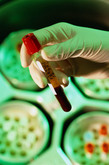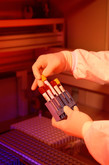Biosimilars
FDA approves Amgen’s and Johnson & Johnson's the risk evaluation and mitigation strategy (REMS) for erythropoiesis-stimulating agents (ESAs)
Amgen and Johnson & Johnson (J&J) announced on 16 February 2010 that the US FDA approved the companies' risk management strategy for patients with chemotherapy-induced anaemia who are receiving erythropoiesis-stimulating agents (ESAs), including Amgen's Aranesp (darbepoetin alfa) and Epogen (epoetin alfa), and Johnson & Johnson's Procrit (epoetin alfa).
Improving effector functions of MAbs for cancer treatment: Enhancing antibody-dependent cell-mediated cytotoxicity (ADCC) and complement-dependent cytotoxicity (CDC)
Mr Akito Natsume et al. of Kyowa Hakko Kirin, Machida-shi, Tokyo, Japan, have shown to improve effector functions of monoclonal antibodies (MAbs) for cancer treatment by enhancing ADCC and CDC, as published in their review article in Drug Design, Development and Therapy 2009:3 of December 2008.
Aglycosylated IgG mAbs can be engineered to display unique FcγR selectivity that mediate antibody dependent cell-mediated cytotoxicity
Until recently, bacterially derived monoclonal antibodies (mAbs) were unable to recruit innate immune cells and were thus ineffective at raising an attack against tumour cells. However, Mr George Georgiou et al. of the University of Texas, Austin, found that engineered mutations in the Fc domain can improve innate immune cell recognition by mAbs manufactured in bacteria, as published in the Proceedings of the National Academy of Sciences.
The study stems from efforts to make therapeutically useful mAbs in bacteria. A key roadblock is that bacterially manufactured antibodies lack Fc region glycosylation. “Antibodies that are not glycosylated cannot be recognised by immune cells,” said Mr Georgiou. In the article it is described how aglycosylated IgG variants expressed in bacteria that selectively bind FcγRI potentiate tumour cell killing by monocyte-dendritic cells. The authors explain that the N-linked glycan of immunoglobulin G (IgG) is indispensable for the interaction of the Fc domain with Fcγ receptors on effector cells and the clearance of target cells via antibody dependent cell-mediated cytotoxicity (ADCC). E.coli-expressed, aglycosylated Fc domains bind effector FcγRs poorly and cannot elicit ADCC.
US FDA prepares for biosimilars in 2011 budget plan, despite stalled healthcare reform bill
Increasing inspections and creating a regulatory pathway for the approval of biosimilars are among the most important areas of the US FDA's fiscal 2011 budget request, US Department of Health and Human Services (HHS) Secretary Ms Kathleen Sebelius says. In testimony before the House Energy and Commerce Committee on 4 February 2010, Ms Sebelius focused on funds included in the budget request for the FDA's efforts to improve medical product safety, including increased inspections and investment in tools to enhance the safety of increasingly complex drugs and biologics.
Bionomics of biosimilars - Indian options for investors
As reported by Ms Nayantara Som in BioSpectrumIndia of 13 January 2010, biosimilars are said to be the next big cash cow for India. However, players have many knots to untangle before they can have a firm grip over the economics of the market.
Bionomics of biosimilars – EU and US markets not easy for India
As reported by Ms Nayantara Som in BioSpectrumIndia of 13 January 2010, biosimilars are said to be the next big cash cow for India. However, players have many knots to untangle before they can have a firm grip over the economics of the market, she warns.
Bionomics of biosimilars – Indian opportunities
As reported by Ms Nayantara Som in BioSpectrumIndia of 13 January 2010, biosimilars are said to be the next big cash cow for India. However, players have many knots to untangle before they can have a firm grip over the economics of the market.
Bionomics of biosimilars – India’s next big cash cow?
As reported by Ms Nayantara Som in BioSpectrumIndia of 13 January 2010, biosimilars are said to be the next big cash cow for India. According to her, however, players have many knots to untangle before they can have a firm grip over the economics of the market.
FDA accepts Teva’s biosimilar filgrastim BLA, Amgen not
The US FDA has accepted Teva‘s application to sell a biosimilar version of Amgen's Neupogen (filgrastim), although the biotech giant is working to block the move in court.
XM02, a granulocyte colony-stimulating factor (G-CSF), is designed to treat severe neutropenia, a haematological disorder characterised by an abnormally low number of white blood cells. If approved, the drug would be marketed under the name Neutroval by US pharma company Hospira, which in 2009 acquired worldwide rights to the new version in a deal that also saw it gain manufacturing capacity for filgrastim and pegfilgrastim - a long-acting version of the drug marketed by Amgen as Neulasta. The worldwide market for Neulasta and Neupogen currently stands at more than US$2 billion.
Abbott: Non-responding RA patients with anti-infliximab antibodies may switch to less immunogenic anti-TNF
In the race for biosimilar/biobetter monoclonal antibodies (MAbs), it is interesting to compare originator MAbs, e.g. mouse-human chimeric infliximab (Remicade) of Johnson & Johnson’s Centocor versus Abbott’s fully human – and thus less immunogenic – adalimumab (HUMIRA).











